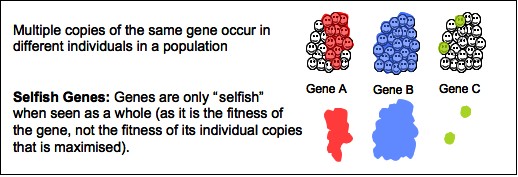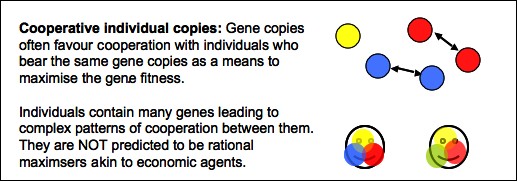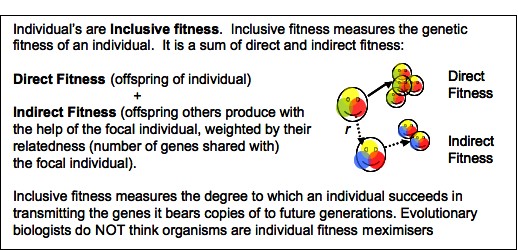I get really irritated when I see writers in the social sciences characterise evolutionary biology as somehow being based on the same assumptions as rational choice theory. Here is the first paragraph from a book chapter I saw today which motivated me to start this blog and write this entry...
"Theories of cooperation in both biology and the human social sciences have had a
turbulent history. During the nineteenth and early twentieth centuries, it was
common to regard societies as like organisms in their own right. This holistic
worldview was largely replaced during the middle of the twentieth century by a
more reductionistic view that sought to explain as much as possible in terms of
individual self-interest. In evolutionary biology, this trend was represented
by the rejection of group selection in favor of “the theory of individual
selection” and ultimately “selfish genes.” In the human social sciences, the
trend was represented by “methodological individualism” (Sober and Wilson 1998;
Wegner 1986) and especially rational choice theory in economics, which assumes
that all human preferences can be understood in terms of individual utility
maximization, with the utility usually conceptualized as material gain (e.g.,
income)."
Of course I agree that saying humans behave as rational self-interested utility maximisers is totally silly in many situations particularly when it comes to looking at humans in a social context. It’s a shame that rational choice was so unquestionably accepted, and its given rise to some awful government policies. People in the rest of the social sciences (sociology, anthropology etc.), from the start could see how flawed rational choice was, and clearly as the main areas of their interest fell into the realm where rational choice failed, they disliked the theory intensely. So as the world started to talk in terms of rational choice and individualism I can imagine how irritated whole departments of anthropologists were getting...
It took a lot of empirical evidence before economists took the criticisms seriously, but fortunately since the mid-90s, the limitations of rational choice are being considered seriously by its supporters. The field of behavioural economics is rapidly expanding and there are exciting and inspiring cross-disciplinary collaborations happening between economists and social science disciplines (economist-psychologist, economist-anthropologist etc).
So I agree with what this paragraph says about economics. What about evolutionary theory? To someone outside the field, it sounds like a similar story is going on...in the 1970s, the collectivist "group-selection" ideas were finally extinguished, and everything was studied in terms of individual maximisation, indeed biologists went one step further and by the end of the 1970s were talking of "Selfish Genes"...and like rational choice, the theory had its opponents - especially with the claims about human behaviour made in a inaccuracy-ridden coffee table book (see the Sociobiology EO Wilson controversy). The critics labelled this new way of evolutionary thinking as “NeoDarwinism” (by the way, biologists never talk of Sociobiology or NeoDarwinism, its evolutionary biology and social evolution).
Starting in the 1980s and continuing today, the “Selfish Gene” ideas have been challenged and a new way of looking at evolutionary biology from a group - or multi-level - perspective has challenged the "NeoDarwinian" ideas. In recent years, this has lead to a flurry of Science and Nature papers by leading economists suggesting how human sociality can be understood as a group adaptation. OK, I'll stop there with my account of what "NeoDarwinian" evolutionary biologists think.... For anyone interested in this topic most of this historical story will be old news anyway. For any biologists reading this, I don’t want to piss them off any more!
I'm not going to have time this evening to go through all the misconceptions in detail in this article - but I'll start with the biggy...that evolutionary biology rejected group-think and went for an individualist approach.
Before I go on, if you are interested, I humbly suggest you read this paper I've written with my colleagues at Oxford which we've submitted to the Journal of Economic Literature. It lists in detail many of the misconceptions I'll not doubt find myself writing about in this blog. If you would like further reading go there and then see the references therein.
Evolutionary theory DOES see individuals as fitness maximsers BUT evolutionary theory DOES NOT see the individuals fitness (number of offspring) as the maximand.
Defining the “Selfish Gene”
Multiple copies of the same Gene occur in different individuals in a population (if you are members of the same species, the vast majority of your genes will be identical, after all we share 97%+ of our genes
with a chimp).
Selfish Genes are only “selfish” when seen as a whole (as it is the fitness of the Gene, not the fitness of its individual copies that is maximised). As one Gene may be common to several species, for many Genes the individual gene copies over which it maximises are spread across a diversity of individuals. It has been shown formally (with maths) that Genes (i.e. all copies of a particular Gene) can be accurately described as maximsers.

The "selfishness" here means maximsing its own transmission, not any other more emotive / morally loaded meaning of the word selfishness. As an aside, I work in the same as Richard Dawkins and colleagues tell me he now wishes he called his book “The Self Interested Gene” but at the time decided the (less accurate) catchier title was preferable…I think he regrets it now.
Consider now an individual person. That person will have millions of COPIES of different genes. The Selfish Gene idea never meant to suggest that an individual copy would be expected to behave selfishly.
Indeed most gene copies favour cooperation with individuals that also have a copy of the same gene...because doing so maximises the Gene fitness. It’s a shame there is not two words, one for a Gene and one for one of its many gene copy. I’m using Gene and gene.
So I stress: Cooperation is expected because we share copies of the same "selfish" Genes. Indeed at the individual level its more accurate to think of SOCIAL GENES, not selfish genes.

As individuals contain many genes, complex patterns of social behaviour are expected to occur between them. Individuals (humans) from an evolutionary perspective are NOT predicted to be rational maximsers akin to economic agents...their genes are (but as genes have copies spread across many individuals the way rational choice-style theory is applied it very different from the way we'd apply it assuming individual people are the economic agents).
Defining Fitness
How can we the define fitness in a useful way that helps us understand behaviours that individuals (or groups) perform that we are interested in (like human cooperation)? Gene fitness is great, but its not very useful if we want to go out and try to collect data to test evolutionary theories. The answer is we can measure an individual’s fitness as it inclusive fitness.
Recently, it has been shown formally (with maths) that it is accurate to say that an individual is adapted to maximse its "inclusive fitness". We can say it is a natural law (as real as Newtons laws of physics) that natural selection acts to maximise inclusive fitness (or from a Gene level, its equivalent to say natural selection maximises Gene fitness).
By the way, the same group of mathematicians have looked at groups (population-level) and have found it is usually impossible to define fitness from a group perspective. It can only be done in very restrictive situations (which are if the group members are identical or the group members are unable to operate freely). This means, unless its one of the special situations, natural selection cannot be said to operate at the group level. Natural selection can always be understood at the individual level (via inclusive fitness) or at the gene level (via gene fitness). This is a fascinating, but complex topic; I’ll return to in the future.
People say natural selection is just a theory, but it’s as real as the theory of gravity. When Darwin was around, we did not have the understanding to develop the maths. During the twentieth centaury, a series of excellent biologists (Fisher, Hamilton and Price being the big three) have formally defined with maths the process of natural selection, confirming it is a phenomenon just a real and universal as gravity (if we looked at life on other planets, the maths would be the same, as it is if we think of evolution in any other system). If you are an evolutionary biologist, you'll recognise the equation in the banner of my blog as the E=mc2 of evolutionary theory. It is the Price equation and the derivation from it of Hamilton's Rule (rb-c>0). SO there IS an equation to explain evolution (its just more complex and less well known that the most famous in physics).
What is inclusive fitness?
Inclusive fitness measures the degree to which an individual succeeds in transmitting the genes it bears copies of to future generations. To calculate the inclusive fitness of an individual you need to consider two things: an individual's direct and indirect fitness.
Direct fitness is the reproductive value (the number of offspring) of an individual. Many problems have arisen by thinking we can only consider inclusive fitness as equal to just the direct fitness – if you do this you can think of an individual’s fitness in a similar way to that of an economic agent that maximses utility. I should add that in practice, biologists often take measures that are related to direct fitness and assume this can infer what the inclusive fitness of the animal might be (e.g. you measure antler length, clutch size, body mass, territory size, number of mates and assume these are proxy measures of fitness). Whether this approach is valid or not depends on the question you are asking. If you want to know anything about social behaviour it is not. The big problem with many writers in the social sciences is they think the indirect fitness part is much less important than it is…
Indirect fitness, is the number of offspring that others produce as a result of the individual helping them. The number produced it weighted by the relatedness between them.

I'll have to discuss relatedness in detail in the future – relatedness in evolutionary biologly is a statistical measure of sameness – it can be positive or negative (its not right to think of it as equivalent to genealogical kinship)...indirect fitness effects are often significant, even in large groups.
Thoughts on the Great Confusion
In the future, I’ll write more about the different ways you can model natural selection and the different ways that you can get cooperative behaviours arising from it. One thing I'll say now. Its a terrible shame how much work is being re-invented/misinterpreted due to these misunderstandings.
For example, many of the recent models of human cooperation use a between-within group selection approach which often makes it very hard to understand whether the behaviour being studied is altruistic or mutually beneficial, spiteful or selfish. I've seen models with statements like "we examine a model of human cooperation evolving between unrelated individuals" that actually works because of the indirect fitness benefits (so it relies on relatedness)... the way the maths is done (considering evolution in terms of between and within group selection) makes this fact obscure. Knowing why models work is obviously important because otherwise the model conclusions could be misapplied to real-world situations where they could not hold. I’ll write more on this in the future.
Just to stress, in these models the underlying process is identical to that which may be examined in a model a biologist typically uses, the way you do the maths is a matter of preference. However all to often, people say that by modeling the process differently they are talking about a different process (making a distinction between a group or individual level selection process). This is just not the case, no matter what models you use (gene-level, individual inclusive fitness or between-within group selection models, it should always be straightforward to get back to the Price Equation. The reason the biologists have settled mainly on one approach (doing models from an individual perspective) is because they have found them to be the most useful - offering more intuitive results that can readily be tested and allowing more complex questions to be considered.
OK, that’s enough chat from me. To conclude I re-stress that evolutionary biologists do NOT think organisms are individual fitness maximisers!
Thanks for reading, Claire



Comments